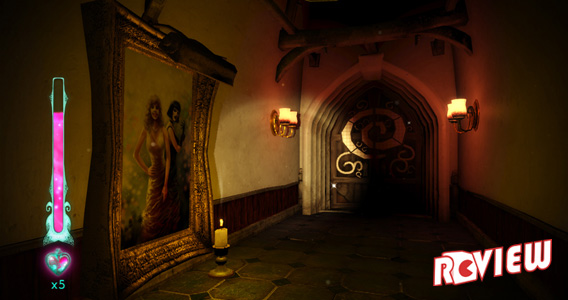
Creating a haunted house game for the Kinect is a noble pursuit. A shaky hand naturally lends itself to acting as a flickering flashlight, and players are forced to open doors that could reveal unspeakable horrors with their own two hands, rather than the press of a button, enhancing the experience of being an active participant versus a passive observer – key to the evolution of the horror genre via the videogame medium.
Last year saw Sega attempt to strike first blood on the peripheral with Rise of Nightmares, a gritty game of bloody nurses and sharp weapons that asked players to use their body to punch and kick the cream-filling out of the undead. The violent workout met with mixed results in the attempt to stretch the narrative and physical experience into a retail release.
Enter NanaOn-Sha, otherwise known as the people who brought you the music rhythm genre with titles like Parappa the Rapper and Um Jammer Lammy, now teaming up with Zoë Mode to bring their own full-body spin on the concept on a smaller scale with the Xbox LIVE Arcade release of Haunt.
Although comparing the two games mechanically is helpful, separating them thematically is essential – where Sega sought a B movie slaughter-fest, Haunt is a more lighthearted horror affair. While the game offers jump-scares that get the blood pumping, the spirit of fascination and charm found within the experience is more apt to leave you smiling by the end instead of covering your eyes.
That said however, the game will ask you to cover your eyes at times, though only when set upon by goggle-wearing ghouls.
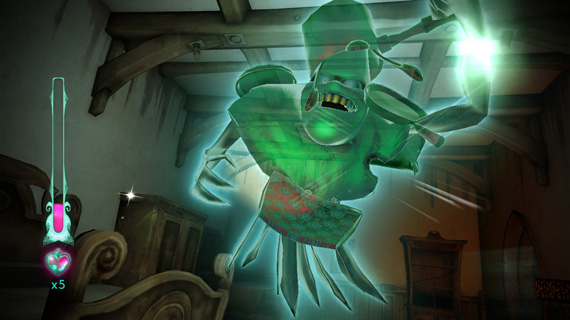
Players enter Haunt’s mansion without explanation, regaining consciousness to the sound of Benjamin Muldoon’s voice, who quickly turns out to be both the owner of the mansion and a man trapped within the canvas of a painting. In order to both instruct the player on the evolving rules of the game, and to provide a measure of company during an isolating experience, Muldoon can move to any painting within the mansion.
Muldoon is also voiced by Double Fine’s Tim Schafer, providing a voice that lends an incredible measure of warmth and entertainment, enough to almost justify the purchase in order to simply listen to him talk, and perhaps even justify calling Schafer at home to listen while he tells you about his day – should you find the means to call him, please don’t tell him where you got the idea. Normally the dialogue of NPC’s leaves me searching for the skip feature, which Haunt does provide, but this was the first time in recent memory that I longed for an absent “tell me more” button.
Muldoon leads the player to a machine powered by four glowing vials known as Phantaflasks. Before the final flask can be inserted however, ghosts make off with three of the vials, escaping behind three separate doors leading to larger areas of the mansion – you can probably see where this is going. Player’s must tackle each of the three areas in order to retrieve the flasks and help Muldoon with an objective that remains purposefully vague in order to have a bit of fun at the player’s expense in the final moments of the game.
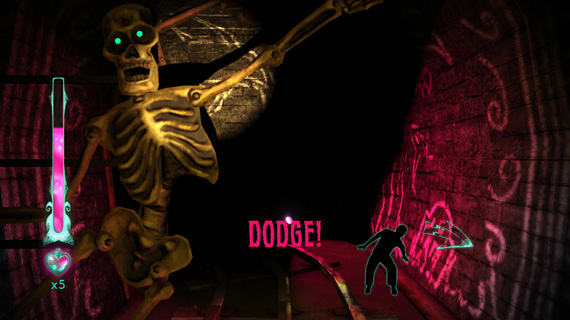
The three areas share plenty of similarities, offering long winding hallways with doors leading to rooms filled with cabinets and drawers that literally shake in begging to be opened by the players outstretched hands – curiously, the game is quite insistent that you also close each door or drawer when finished. The bulk of item discovery involves spheres of vitality that keep the health bar topped up, and vitality vials that will refill said bar should you perish along the way – though the relative ease of the title makes it hard to imagine this happening. Light exploration will have players searching for missing mechanical parts or keys, usually by searching the rooms on one end of a stage and then returning to those on the other side. Since players can’t save whenever they please, stage segments take physical exertion into consideration and as such makes the idea of ever getting lost hard to imagine.
Losing vitality also factors into the scoring for each stage of the game, which adds to leaderboard totals that are a nice enough touch, though it is hard to imagine anyone dancing around whilst proclaiming their domination of Haunt based on score accomplishments.
Moving through the hallways of Haunt is a matter of aiming a flashlight with your outstretched hand and walking on the spot to move toward the focal point of light created by that action. The player can alter their speed by moving on the spot quicker, and I found movement in general more comfortable than Rise of Nightmares, which asked players to put a foot forward and hold it there to move ahead, if only because with Haunt you need a lot less space to get the job done.
I happened to be playing in a much smaller room than usual, and lifting my knees while walking on the spot never failed to move me forward – though there were times where I started physically moving forward because it is apparently very hard to walk on the spot without doing so. There are occasional jitters that crop up while readjusting your direction at times, but these are small instances that never derail the journey.
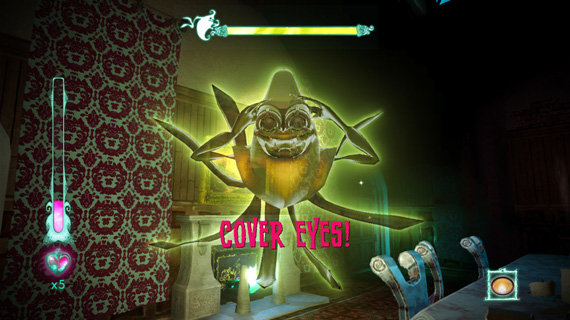
The areas offer a variety of activities, from a carnival styled tunnel train ride, to audio tricks that require moments of silence from the player via the Kinect microphone. The game is constantly attempting to change tactics and looking for ways to get the drop on players, aided by the relatively short one-day nature of this XBLA release that leaves little space for repetition. With that said however, the player’s role in essentially reacting to phantom aggression largely involves dodging, ducking, and swinging both arms repeatedly.
Haunt’s confrontations largely occur via four primary ghost types. There’s an orange ghost that hurls projectiles that must be swatted back, a yellow ghost that requires you to cover your eyes until you get a chance to snap its goggles, a heavier green ghost that takes powerful swings at the player that must be dodged while waiting for a chance to counterstrike, and a shrieking pinkish ghost that must be shouted back at – be aware that people in your household may come running to see what the problem is the first time this occurs. The flashlight serves as a means of draining the health of each ghost as well, often when the initial response has temporally dazed them.
This review won’t manage to name every small moment of interaction or surprise that charmed me along the way, and I wouldn’t want to list them all off and spoil your supper anyway. The important point is that the game never stops trying to pull the player in deeper, including using Kinect camera trickery to literally make players part of the experience.
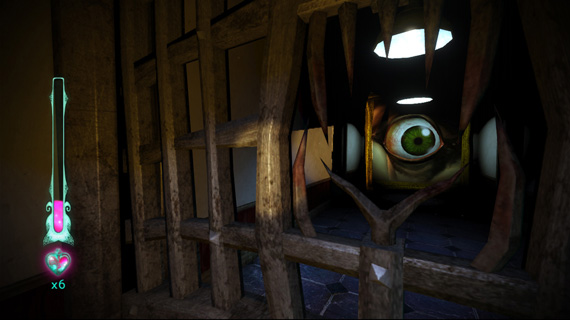
By the end, the tricks do get familiar, and eventually it becomes easy to expect certain surprises while gathering those Phantaflasks. But Haunt never tries to delay the trip, and in the same way a good piece of writing uses only as many words as it needs, so too does Haunt only stretch the journey for as long as it can provide some new means of interaction. The game takes the quality over quantity route to avoid overstaying its welcome.
And the Kinect needs more games that don’t over-extend their welcome simply to justify retail existence, reaching an audience that may not know Xbox LIVE Arcade even exists, but have fresh reason to discover it here. Despite a few hiccups and a level of ease that makes it tempting to suggest the game is entirely intended for a younger audience, Haunt is attempting to build its mansion on more sensible ground for the peripheral, which is certainly reason enough for Microsoft to give the title more of a push and a recommendation for any Kinect owners in the audience to grab a room in this mansion for the night.
NanaOn-Sha, Zoë Mode
Publisher
Microsoft Studios
System
Xbox 360 (Kinect) (Xbox LIVE Arcade)
Modes
Singleplayer
Release Date
January 18th, 2012
Price
800 Microsoft Points
*A copy of this title was provided by the publisher for review
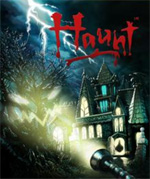
looks ALOT better than rise of nightmares. Going to have to try this out
Comment by sean — January 27, 2012 @ 5:44 pm